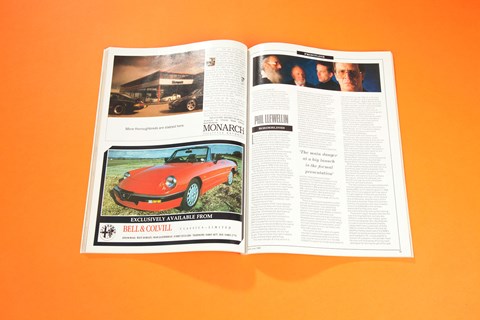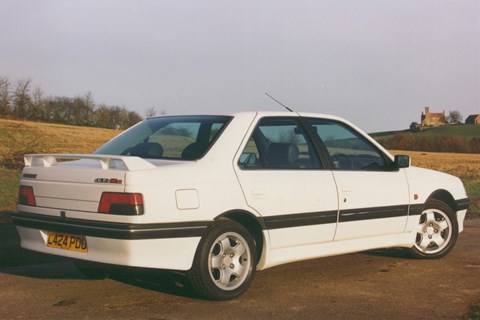► Classic Phil Llewellin column from June 1989
► A wry look at the world of major car launches
► Champagne, charted jets and ‘narcoleptic’ presentations
Lucullan, lavish, spectacular, prodigal, splendiferous, glittering, theatrical, awe-inspiring, extravagant, dramatic, over the top and money no object are words that cannot be applied to the launch of Britain’s most significant post-war car. According to my archives, the mighty but ill-fated British Motor Corporation’s epochal Mini was revealed to the world’s trilby-hatted press at a military proving ground in Surrey. The exercise was spread over two days – one for the locals, one for the rest of the universe – and took place only a week before 26 August 1959, when Joe and Joanna Public were let in on the secret.
Bill Boddy, who has edited Motor Sport since chariots returned after Noah’s flood, reported driving six miles ‘round the speed track and snake’ in a Morris Mini-Minor. He climbed a one-in-four gradient, confirmed the ‘absence of any vicious oversteer’ on a dry skidpad, chatted with Alec Issigonis over lunch, then went home. In visual terms? The report provided nothing more art-and-action stunning than a small, grey snap of a Mini-Minor apparently parked beside a flowerbed, but described as cornering at 40mph ‘with complete equanimity’.
Regular readers of Mr Carte Blanche Bishop’s social diary will have noticed that car launches now are a touch more elaborate. Chartered jets speed group after group of scribblers to exotic locations, where the host company is often based for a month or more.
BMC’s budget for sending the Mini down the slipway is now exceeded by the cost of champagne poured into the hack who covers motoring, table tennis and offences involved sheep, for the Twil Bulge. That could be why I get invited to so few of these tribal gatherings. The main danger at a big launch is being subjected to a formal presentation where top-level executives describe, in detail, every nut, bolt, wire, weld, strand of fabric and square micron of paint. In my limited experience, Audi gets the gold medal for providing a very clear impression of what Eternity is going to be like. These narcoleptic marathons are always followed by question-and-answer sessions for the benefit of the group’s chronic insomniacs. Keeping the barbarian horde away from the booze for a little longer is another reason for inviting questions. But why ask them in front of all the other hacks? If the answer is likely to be worth immortalising in print, it makes sense to have a quiet word over the post-prandial cognac.

Already this year I have exceeded last year’s modest launch total. This has been achieved thanks to such newcomers as the admirable and eye-catching Renault Espace Quadra, Ford’s Fiesta – very competent, and certain to sell by the million, but short on character – Diahatsu’s macho-in-miniature Sportrak, and the ‘integrated transmission’ variations on Peugeot’s award-winning 405 theme. The fact that there are now two paid-for Pugh Jones in the family – Mrs Llewellin’s 205 and the Ancient Pater’s 309 – was one good reason for accepting the latter invitation. Being able to tick Sardinia off the bingo card, without having to pay for the privilege, of course, was another.
These terra incognito expeditions often provide an opportunity to recce potential holiday destinations. I can report that Cagliari, the capital of an island 1300 square miles bigger than Wales, is hard to beat if you prefer oil refineries and chemical factories to the more traditional Mediterranean attractions. The best thing about Cagliari is that it accounts for about one-sixth of Sardinia’s population, which doesn’t amount to much, so there’s very little traffic elsewhere.

Having the virtual freedom of superb mountain roads encouraged even this apostle of self-preservation to turn the wick up and have a lot of fun in the 405 Mi16x4. This stylish all-wheel-drive saloon’s vital statistics include 160bhp, a claimed maximum of 134mph, and a guaranteed minimum of 60bgpm. Bgpm stands for big grins per minute. The rate’s high, because Peugeot’s Mi16x4 is what might be dubbed a supermarket supercar in terms of roadholding, handling, and the sort of traction that enables the 16-valve engine’s full power to be unleashed without spinning a wheel. This crème de la crème versions of the 405 is likely to cost about £20,000 when sales start a few months hence. Patriots will be pleased to learn that the Brits pedalled hard enough to burn more fuel than any of the other groups, which included scribblers from such far-flung journals as the Bangkok Daily Massage.
The scene shifts from Sardinia to Stonehouse, Gloucestershire, where Wycliffe College attempted to educate me in the dim and distant past. Mrs Llewellin suggested I was returning to have my 32nd crack at today’s equivalent of the GCE Oaf Level maths paper, first failed in 1957. In fact, this exclusive resort on the palm-fringed Stroudwater Canal witnessed the official launch of the Healey Motor Company, which should not be confused with the famous Donald Healey Motor Company of Warwick.
But the new venture’s three directors do include Geoffrey Healey Donald’s son is a charming, pipe-smoking engineer who has memories of Healeys being raced by the likes of Tony Rolt and Duncan Hamilton, who went on to win Le Mans for Jaguar, and by Tony Brooks, the dentist who was also one of the best post-war grand prix drivers.
The new company has been established to build latterday versions of the Austin-Healey 3000, which died the death in 1968. One of the many appealing things about this get-together in Stonehouse was the contrast between the cars, which looked very professional, and the way in which they were presented. Peter and Graham Holmes, the brothers who have invested more than £250,000 in the venture, explained that they were more accustomed to engineering than talking.
These born-again Healeys look like the cars that inspired them, but are very different under the high-impact, glass-reinforced polyester skin. Key features include a tubular backbone chassis, independent rear suspension and the 190bhp version of Rover’s 3.5-litre V8. Geoffrey Healey joked about the 3000’s straight-six being so heavy that two men were needed to lift – he paused for a fraction of a second – the cylinder head. No man with that sense of timing need apologise for lacking the gift of the gab.